Slow Cooker Pork Stew
Recipes like my Slow Cooker Pork Stew feel like a win when you have a big family like mine. With barely any hands-on time, I get perfectly seasoned pork that’s so tender it falls apart with a spoon. I load it up with hearty vegetables, all simmered together in a rich sauce made from red wine, beef broth, tomato paste, and butter.
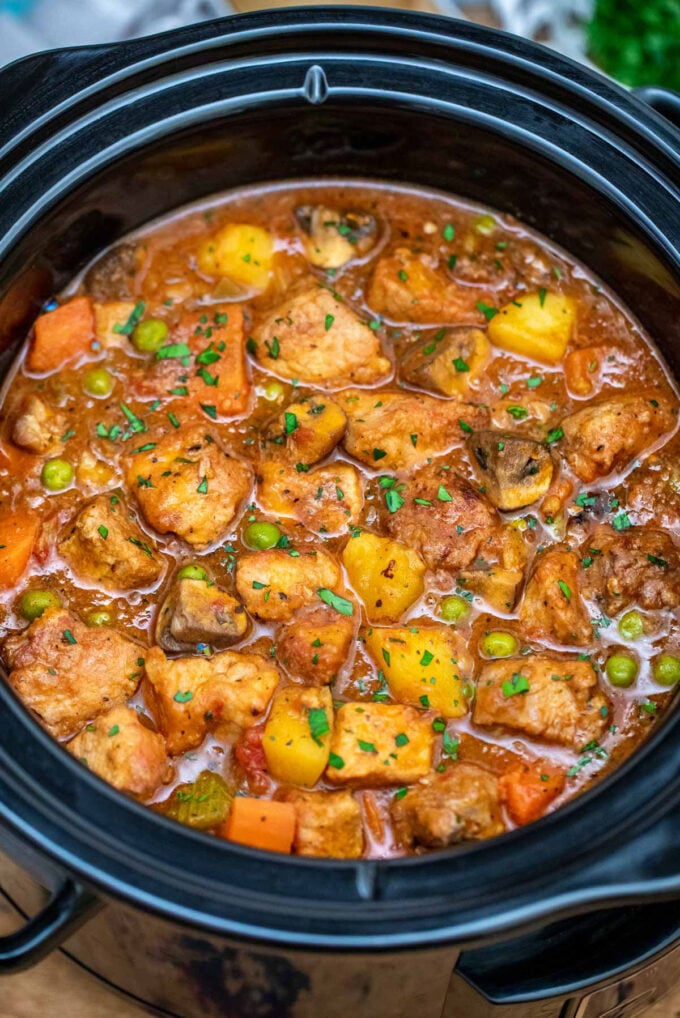
Pork has always been a favorite protein in my kitchen because it’s affordable, versatile, and turns out incredibly tender in slow cooking. Recipes like this one, along with my slow cooker pineapple pork loin and my summer favorite slow cooker peach pork, were born out of that same idea, simple meals that let the pork shine and taste like I put in hours of work when really, the slow cooker did most of the work.
Table of contents
I rely on this recipe during busy seasons when I still want a homemade dinner without being tied to the stove. I usually make a big batch because stew always tastes even better the next day, and if there’s extra, I freeze it in individual containers so I have quick, comforting meals ready to go whenever I need them.

Why you will love this recipe
- Hands Off, delicious On: There’s barely any prep with this one. I just toss everything into the slow cooker and let it do the work. Browning the pork adds extra flavor, but if I’m short on time, I skip it and it still turns out delicious.
- Even the kids clean their plates: This is one of those meals where I don’t have to beg my kids to eat. They gobble it up, veggies and all, without a second thought.
- Easy to tweak: I love how flexible this stew is. If someone doesn’t like carrots, I swap in bell peppers or broccoli and the flavor still works perfectly.
- Leftovers that actually get eaten: Making a bigger batch is a no-brainer. It reheats great, so I always save extra for lunch the next day or freeze a few portions for a no-cook dinner later on.
What you will need
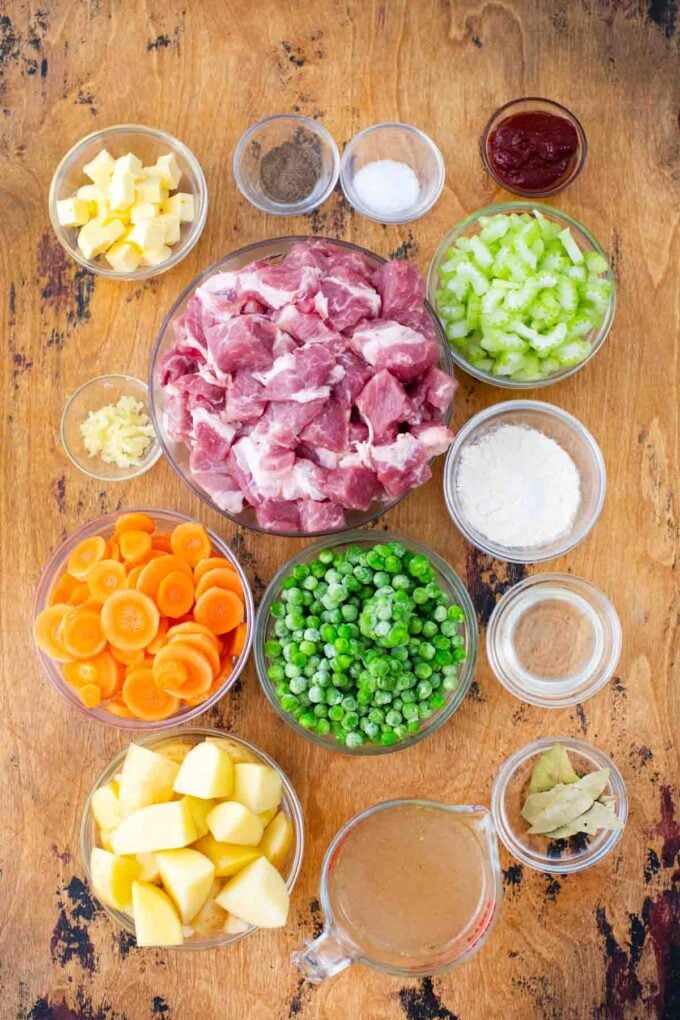
- Meat and coating: I use pork stewing meat, either pre-cut or chopped at home, depending on what’s available. A quick toss in flour and a sear in oil gives it a flavorful crust.
- The base of every good stew: Chopped onion and fresh garlic are my go-to for building flavor. I sauté them in unsalted butter to bring out their sweetness and aroma.
- Liquids and richness: Red wine, tomato paste, and beef broth come together to make a rich base. I use low-sodium broth so I can control the salt myself.
- Vegetables: I keep it simple with baby carrots, diced celery, and halved baby red potatoes. Frozen peas go in too and hold their shape perfectly fine.
- Seasonings: Bay leaves add a soft herbal note while it all simmers. I season everything with kosher salt and freshly ground black pepper.
- For the slurry: I mix cornstarch with warm water to make a simple slurry that thickens the stew at the end.
How to make
Toss: First, I toss the pork in a large bowl with flour, salt, and pepper until each piece is nicely coated.
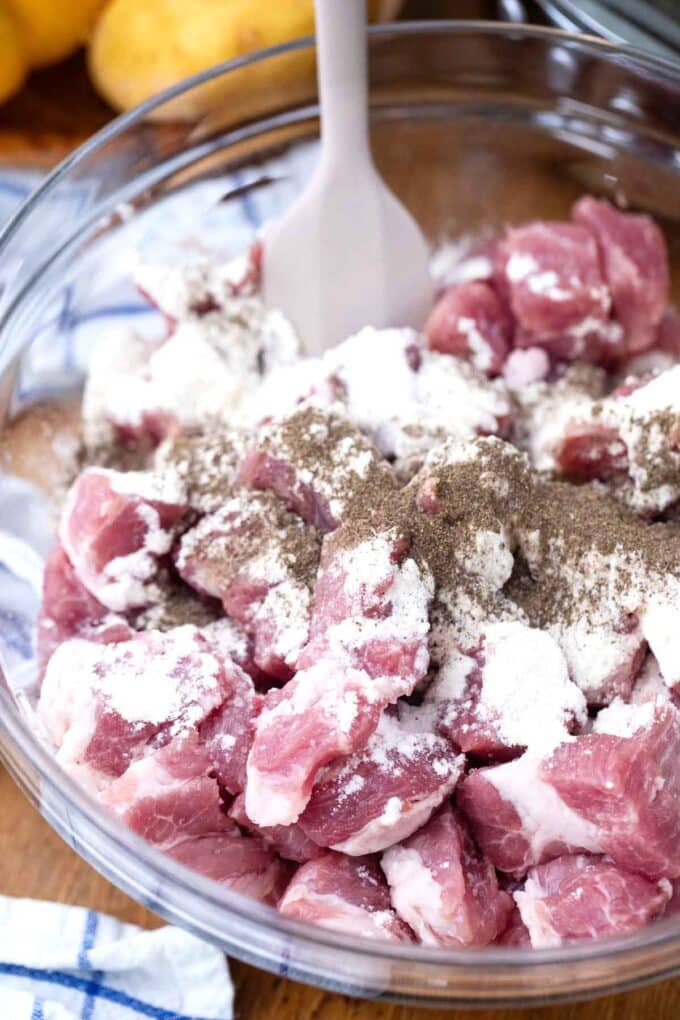
Sear: Then, I heat the oil over medium-high, then add the pork in a single layer and brown it on all sides, about five minutes per batch. As each batch finishes, I transfer the pork straight into the slow cooker.
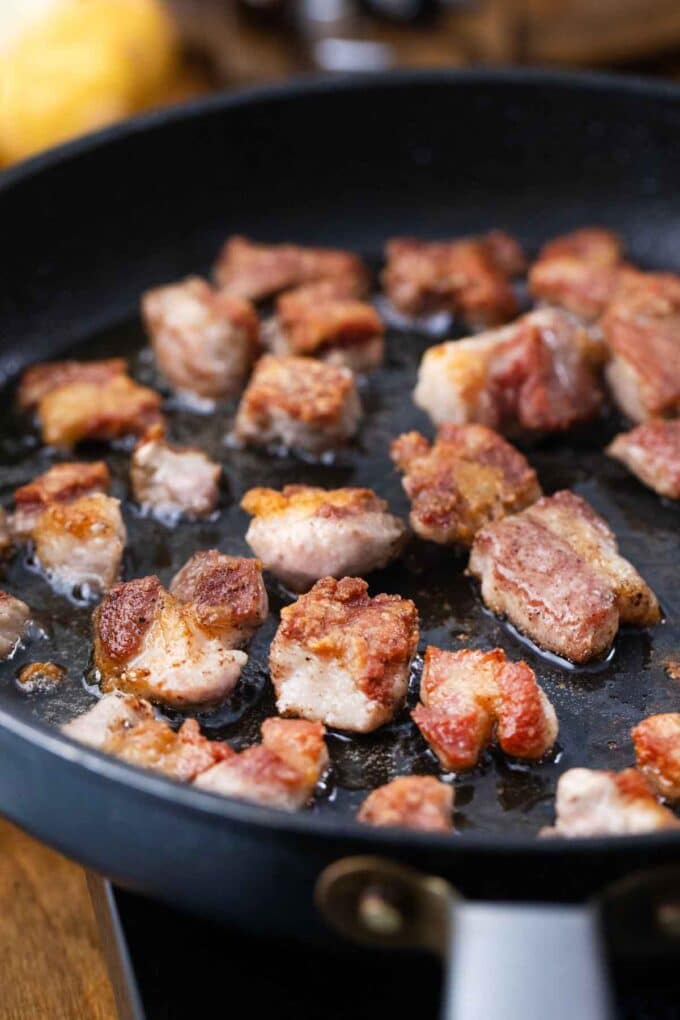
Deglaze and sauté: I pour the wine into the skillet and use a wooden spoon to scrape up all the browned bits from the bottom. Once that’s done, I pour the wine mixture into the slow cooker. Keeping the heat on medium, I melt the butter, add the garlic and onion, and sauté for one to two minutes until fragrant. Then I pour in one cup of broth to deglaze the pan again and get every last bit of flavor.
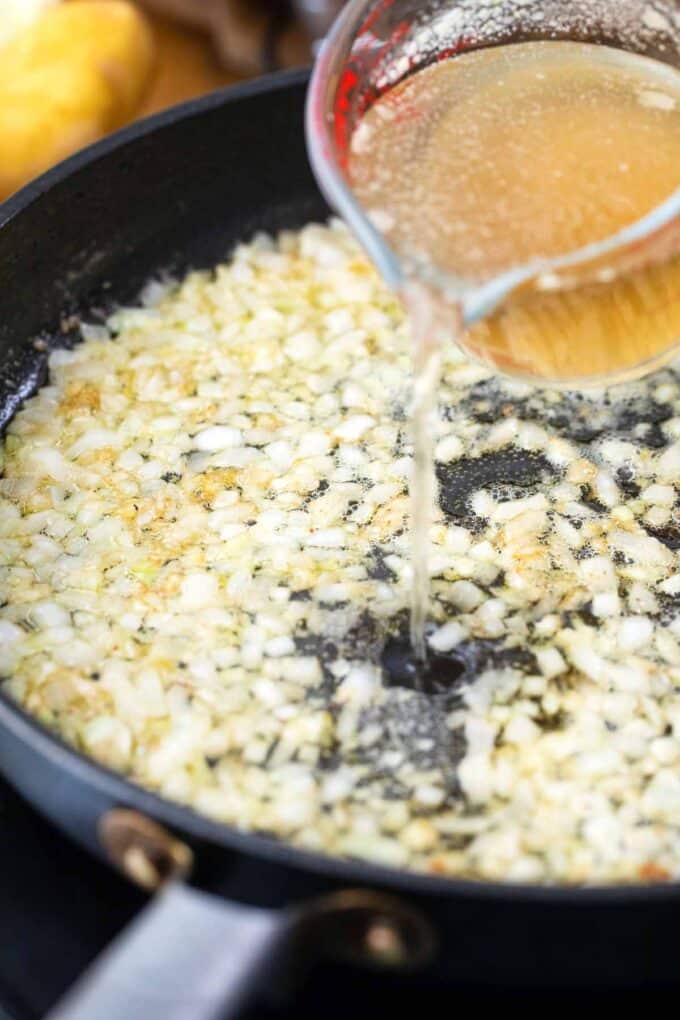
Cook on low: I pour the skillet mixture into the slow cooker, then add the tomato paste, all the veggies, and the rest of the broth. I give everything a good stir, add the bay leaves, salt, and pepper, cover the pot, and let it cook on low for seven to eight hours.
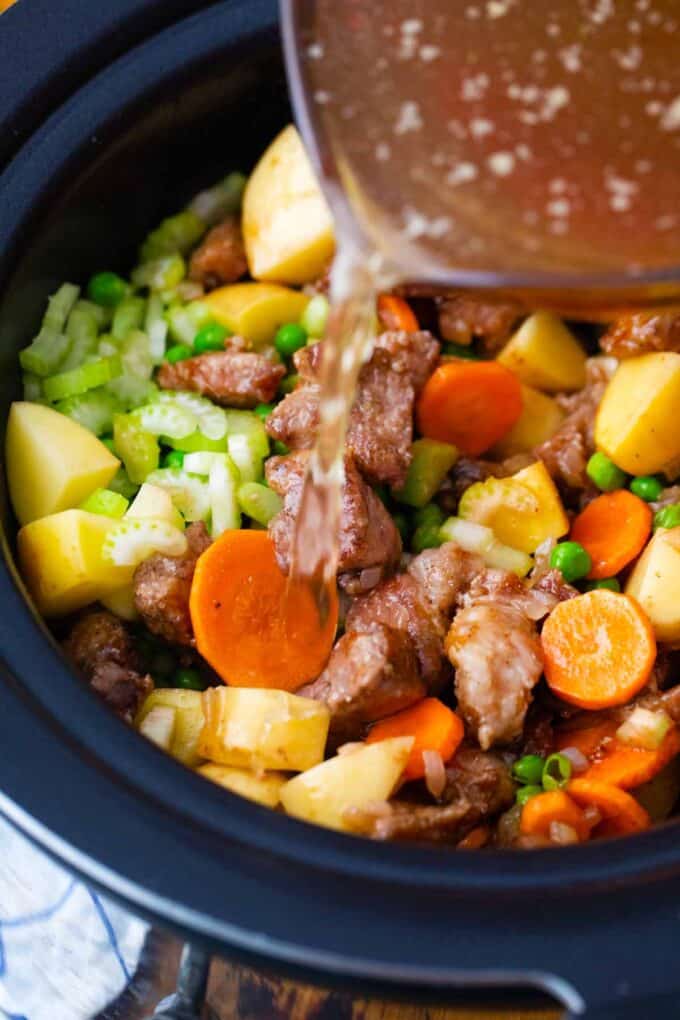
Finish and serve: Once the stew is done, I taste it and adjust the salt and pepper if needed. If the broth is too thin, I either stir in a cornstarch slurry or mash a few potatoes to thicken it during the last 30 minutes, then finish it off with a sprinkle of chopped parsley before serving.
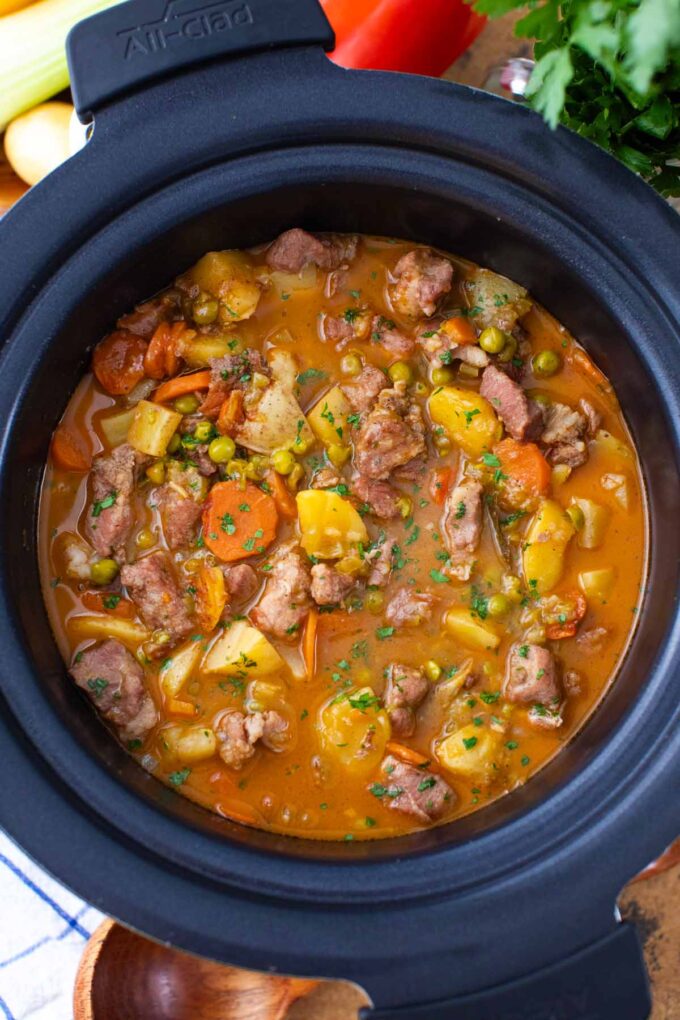
Expert tip
Cooking pork on high or low
One thing I’ve learned over the years is that when it comes to pork, low and slow is the way to go. Different cuts need different times, but in general, cooking pork on the low setting gives it time to braise gently and turn tender as the fat and collagen slowly break down. For this recipe, since the pork is already cut into chunks, it cooks up beautifully in about six to seven hours. That’s just enough time for it to become juicy and full of flavor without ever drying out.
More tips to consider:
- I always keep the lid on the slow cooker while it’s running so the heat stays in. Lifting the lid too often can make it take longer to cook.
- I check the pork with a meat thermometer to make sure it’s done. It should read 145 degrees Fahrenheit when it’s fully cooked.
- When I freeze leftovers, I like to portion them into single-serving containers. That way, I can grab just what I need without defrosting the whole batch.
- If I don’t have wine on hand, I use red wine vinegar or apple cider vinegar. Both give the stew a nice tangy flavor.
- If the potatoes are breaking apart, I wait until about the four-hour mark to add them. Leaving the skin on the potatoes is another way I keep them from getting too soft. It gives them a little more structure as they cook.

Recipe variations and add-ins
- Different meat: If I’m out of pork or just want to change it up, I sometimes use beef, chicken, turkey, or even leftover ham. I keep the amount the same, around two to three pounds of meat.
- Add more veggies: I love adding extra vegetables to my stew. Root veggies like one cup of chopped turnips, parsnips, or sweet potatoes work great, and so do one to two cups of mushrooms, corn, green beans, or bell peppers.
- Spicy stew: To make it spicy, I toss in one chopped jalapeño or a half teaspoon of red pepper flakes.
- Sweet stew: For a little sweetness, I stir in one tablespoon of brown sugar. My kids especially love it this way because it gives the stew a rich flavor.
- Bacon: Bacon is always a good idea. I cook four to five strips until crispy, crumble them up, and add them right into the pot.
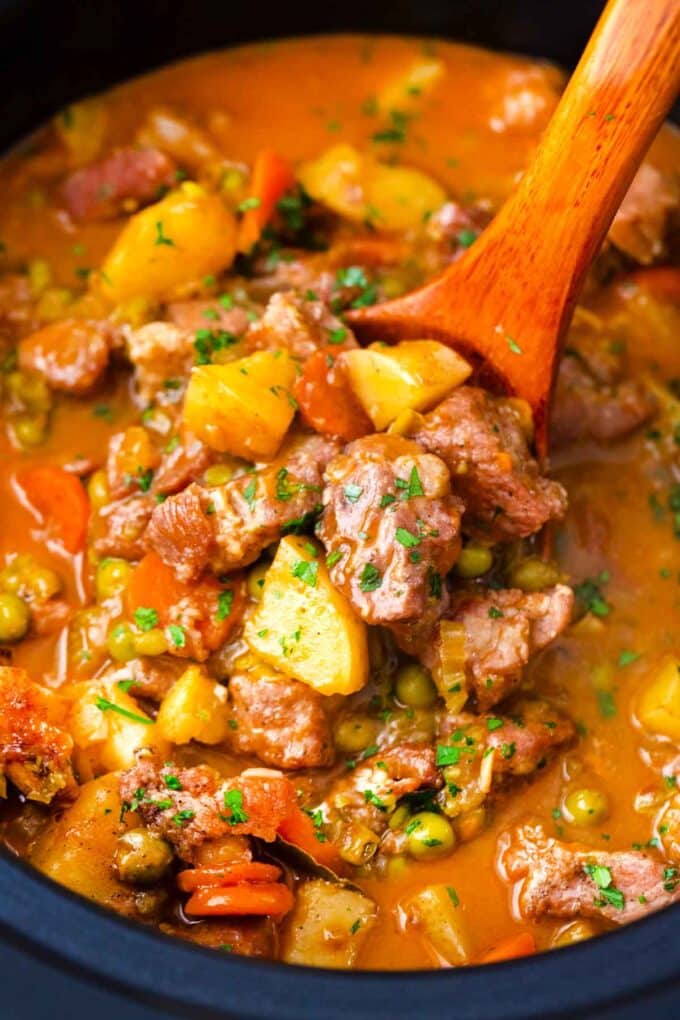
Serving suggestions
Whenever I make this pork stew, I like to serve something on the side that adds a fresh contrast to the stew flavors. One of our family favorites is my strawberry broccoli salad . It’s crunchy, sweet, and just the right balance to the hearty stew, and my kids always go back for seconds.
Sometimes I’ll still put out a basket of warm dinner rolls or buttery biscuits, especially if we have guests over. But on most nights, that bright, colorful salad is all we need to make the meal feel complete. My family always gets excited when I follow this cozy stew dinner with a slice of their favorite dessert, strawberry shortcake pie. It’s the perfect sweet ending after a comforting meal.
How to store leftovers
- Refrigerate: Once my pork stew has cooled to room temperature, I transfer it into an airtight container and pop it in the fridge. It stays fresh for four to five days.
- Freezing: If I need to store it longer, I pour the stew into a freezer-safe container or freezer bag and freeze it. It keeps well for three to four months, and I always label it so I don’t forget what’s inside.
- Defrost: Be sure to put frozen leftovers in the fridge the night before serving for the best flavor and texture.
- Reheating: To reheat, I pour the stew into a saucepan and warm it over medium heat for about five minutes. I stir it now and then until it’s heated through and ready to serve.
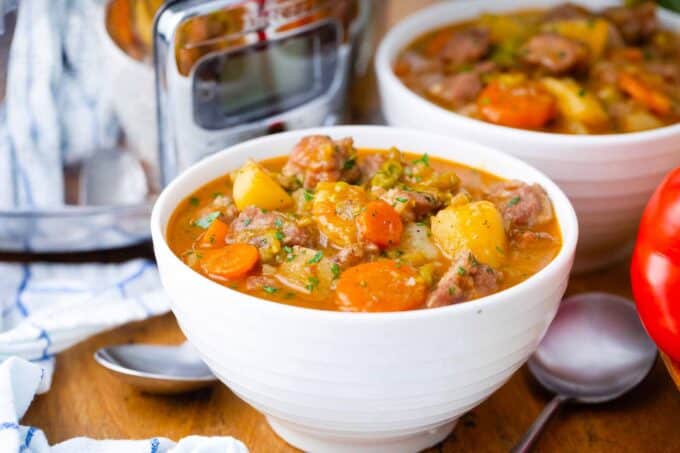
Frequently asked questions
For a stew that cooks low and slow in the slow cooker, I always go with a cut of pork that has plenty of connective tissue to hold together as it cooks. It also needs enough fat to stay tender, juicy, and full of flavor. Pork shoulder or pork butt are my top choices because they strike that perfect balance. I avoid anything too fatty, like pork belly, since it doesn’t have the structure to hold up and would just melt away in the pot.
One of the first things I think of when the pork turns out tough is that it didn’t cook long enough. Make sure it simmers for at least six hours, and if it’s still not tender, let it go for another two to three hours. Sometimes the meat can dry out if the juices escape during cooking, so I always brown the pork first to help seal in the moisture. If I’m using a tougher cut, I’ll soak it in a salt brine or marinade ahead of time to help it stay juicy and tender.
Any type of meat can be overcooked, no matter how you cook it. For this stew, I’ve found that the best way is to set the slow cooker on low and let it go for at least six hours. Cooking it on high can boil the meat instead of braising it, which makes it tougher because it cooks too quickly. And if it finishes early and stays on the heat too long, it can still end up overcooked and dry.
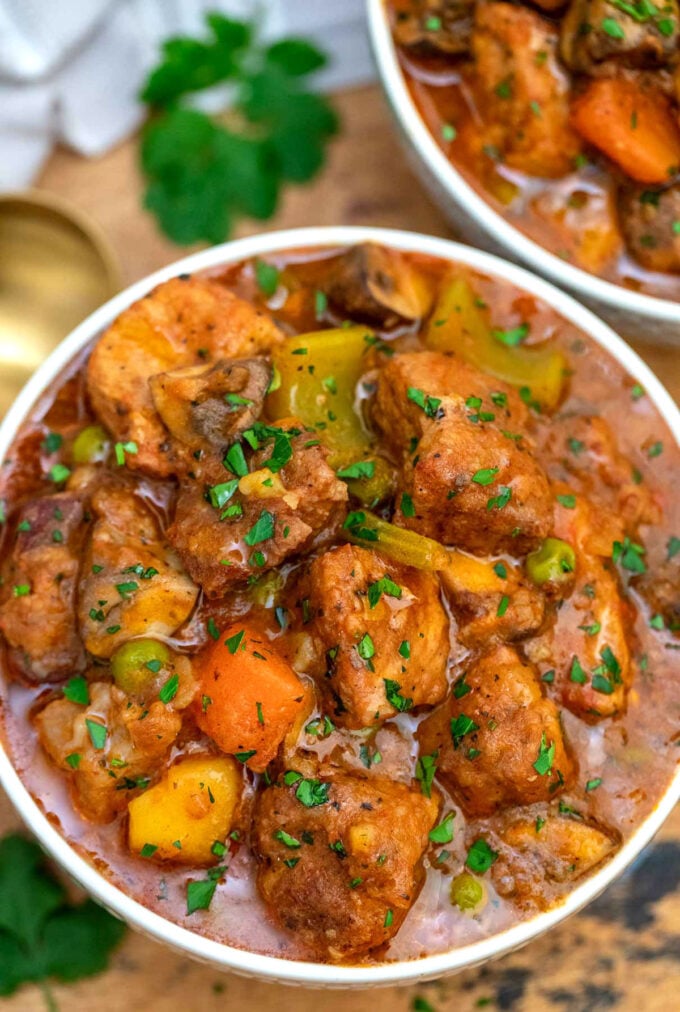
More stew recipes:
Loved this recipe? I’d love to hear from you! 💛 Leave a 5-star rating ⭐️ in the recipe card below and share your thoughts in the comments – I read and appreciate every single one!
Let’s stay connected! Follow me on Facebook, Instagram, Pinterest, and YouTube for more delicious, sweet and savory recipes. Have a question? Ask in the comments, and I’ll be happy to help! 😊 with love Catalina!
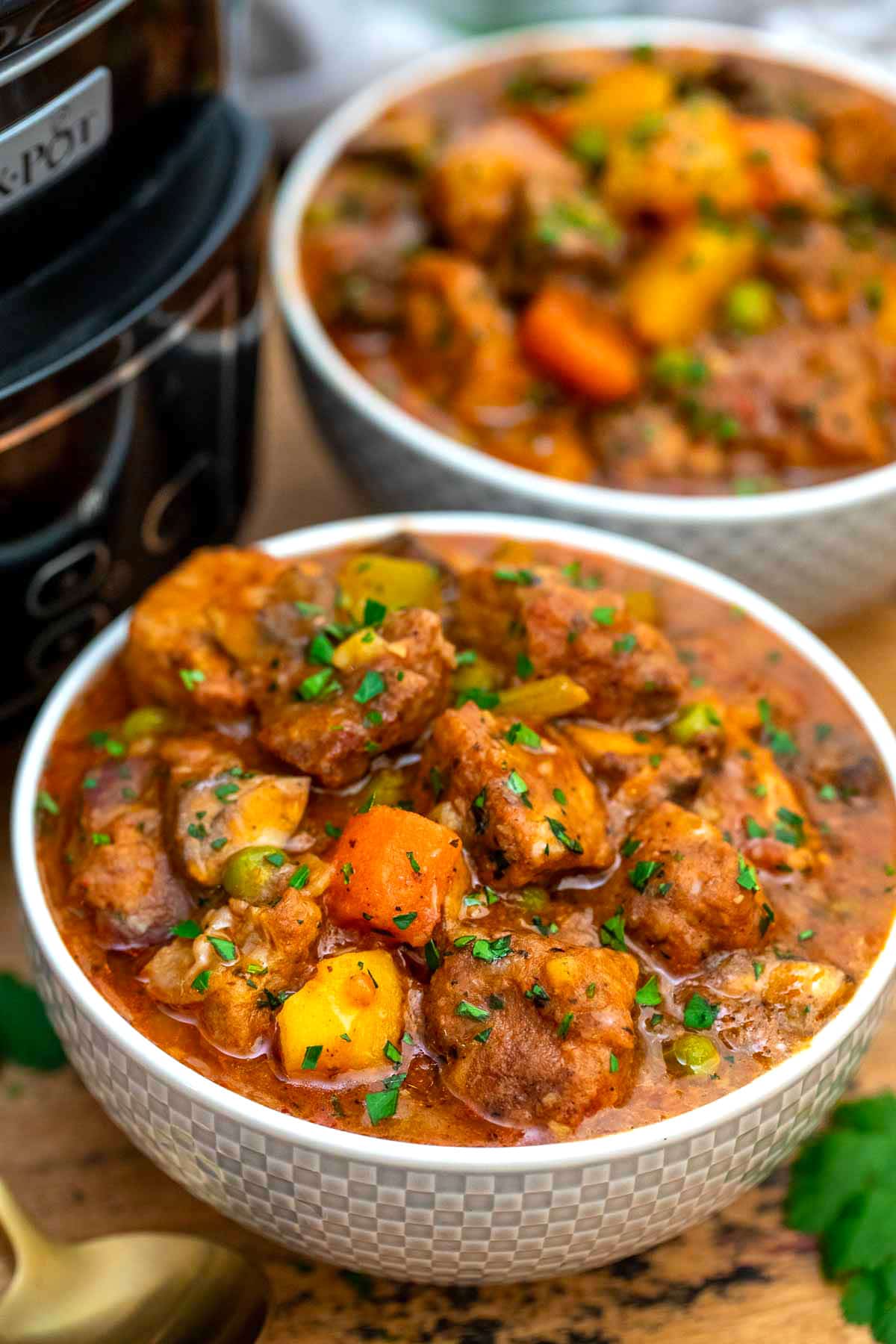
Slow Cooker Pork Stew
Ingredients
Pork Stew:
- 2-3 pounds pork stewing meat trimmed and cut into 2-3 inch cubes
- 1 teaspoon salt
- 1/4 teaspoon freshly ground pepper
- 1/4 cup all-purpose flour
- 4 tablespoons vegetable oil
- 1/3 cup red wine
- 2 tablespoons butter unsalted
- 1 yellow onion peeled and chopped)
- 5 cloves garlic minced
- 2 tablespoons tomato paste
- 5 cups beef broth low-sodium, more if needed
- 4 medium carrots peeled and cut into 1/4-inch chunks
- 1 cup celery diced
- 1 pound mini red potatoes peeled and cut into halves
- 1 cup frozen peas
- 3 bay leaves
Cornstarch Mix:
- 3 tablespoons cornstarch
- 4 tablespoons water
Garnish:
- Chopped fresh parsley
Instructions
- Place pork chunks into a large bowl and sprinkle with flour, salt, and black pepper. Use kitchen tongs to toss and coat evenly.
- Place a non-stick skillet over medium-high heat and add 2 tablespoons of oil. Once the oil is hot, add the meat in one layer, working in batches if needed. Brown on all sides for about 5 minutes per batch. Once done cooking, transfer it to the slow cooker.
- Add the wine to the skillet to deglaze it, scrape the bits from the bottom, and add the liquid to the slow cooker.
- Reduce the heat to medium and add the butter. Once melted, add the onion and garlic and cook for 1-2 minutes. Add 1 cup of broth to deglaze the skillet, using a wooden spoon to scrape the bits that are stuck to it. Transfer the mixture to the slow cooker on top of the meat and add tomato paste.
- Add carrots, celery, potatoes, and frozen peas to the slow cooker.
- Pour the remaining beef broth on top. Add bay leaves and season with salt and pepper.
- Cover and cook on LOW for 7-8 hours.
- Taste and adjust for salt and pepper.
- If you prefer the stew to be thicker, either mash some of the potatoes or add the cornstarch mix.
- Mix cornstarch and water in a small bowl until thoroughly combined. Add the mixture to the pot during the last 30 minutes of cooking.
- Garnish with chopped parsley and serve.
Notes
Cooking pork on high or low
One thing I’ve learned over the years is that when it comes to pork, low and slow is the way to go. Different cuts need different times, but in general, cooking pork on the low setting gives it time to braise gently and turn tender as the fat and collagen slowly break down. For this recipe, since the pork is already cut into chunks, it cooks up beautifully in about six to seven hours. That’s just enough time for it to become juicy and full of flavor without ever drying out.More tips to consider:
- I always keep the lid on the slow cooker while it’s running so the heat stays in. Lifting the lid too often can make it take longer to cook.
- I check the pork with a meat thermometer to make sure it’s done. It should read 145 degrees Fahrenheit when it’s fully cooked.
- When I freeze leftovers, I like to portion them into single-serving containers. That way, I can grab just what I need without defrosting the whole batch.
- If I don’t have wine on hand, I use red wine vinegar or apple cider vinegar. Both give the stew a nice tangy flavor.
- If the potatoes are breaking apart, I wait until about the four-hour mark to add them. Leaving the skin on the potatoes is another way I keep them from getting too soft. It gives them a little more structure as they cook.





That looks like a hearty stew that any family would love. I generally don’t use my crockpot but I know this is one recipe that will be used by everyone.
Ooh, definitely trying this. My husband would love it. He loves anything “meaty.”
Ohh now this sounds like it would be absolutely delicious – I really need to think about getting a slow cooker as I think it would work well for us.
I love when I can use my slow cooker! I am excited to try this out for sure. Yum!
The temps have been up and down in my state. This recipe is going to be perfect for those cool spring nights.
This looks like the perfect comfort dish. I love stew in the winter, but it’s good any time of year!
I haven’t tried pork in the slow cooker yet but it’s definitely on my list to try, will save this for a cold or rainy day.
All those layers of flavors are looking so good. I would love to have some of this warm and comforting stew right now!
I don’t have a slow cooker, but this recipe makes me want to get one! Looks so delicious in the pics.
Stew is one of my favorite foods, it is the ultimate comfort food in my opinion.
This Slow Cooker Pork Stew is making my tummy growl! Looks really delicious and this can totally satisfy my craving. Thanks for sharing.
I don’t care what time of year it is, some comfort pots such as this one are necessary even during a hot summer. Your imagery is so tempting to my eyes that I’ve printed this and will be get back to you on the outcome but it’s sure to delight!
This pork stew is delicious! Our whole family really enjoyed it and it was great for leftovers.
This looks like a wonderfully hearty stew. I haven’t made a soup with pork in it and it would be nice to make a big batch.
We tried this for dinner tonight and it was SO good!I love recipes that are in the crockpot and are very easy!
What a delightful looking hearty stew. This is perfect for chilly night and the best part is how easy it is to make it. Great tip by the way, to add wine to chicken broth. I’m going to have to try that on my next recipe using broth. So tasty. Gotta love the crockpot!
I just made this and it was really good. I will definately be making this again. Thank you so much for this recipe.
Just wondering what the calorie count serving portion is? 669 calories in what? A cup?
2-3 cups
I made it once before, fantastic. Now I have it on again today (luv this pork Stew)
I am very happy that you loved it, thanks for the feedback!
absolutely love it! thank you!
Hi! I am making this tomorrow. I read what you wrote above and it mentions chopped tomatoes, white wine and chicken broth. The recipe ingredients say tomato paste, red wine and beef broth. Which should I use for the pork stew? I will be using pork tenderloin. Thanks for info. Looks delicious.
Hi Jennifer,
I mention in the recipe card to use 1 pound mini red potatoes (peeled and cut into halves), this is on top of tomato paste. Let me know if you have any more questions.
Do we use red or white wine? Beef or Chicken Broth? Thank you for the fast reply! 🙂
Is there a substitution for wine? I’m not much into cooking with wine.
You can try Ginger Ale, or apple juice, or cranberry juice.
Your recipe was delicious. Very tasty, tender pork and veggies. It didn’t thicken, like in your photos. I was so looking forward to a thick stew that stuck to my ribs. It was like a soup, albeit, a good soup. 🙂
Did the cornstarch at the end, it didn’t help.
So happy that you loved it, please try adding more cornstarch next time.
I made this stew yesterday. The only change I made is I used canned beef broth for the liquid. It was delicious. I am passing the recipe along to friends and family.
I haven’t made this recipe yet, but it looks great! I just wanted to let you know that I found a typo in the third step of the instructions:
“Add the wine to the skillet to degraze it”
I’m sure you meant “deglaze.”
Fixed this for tonight’s supper; came out as good as it looks. We used potato starch to thicken instead of cornstarch. We find we get a better result using potato starch. We also substituted beef soup base and water for the beef broth and salt as that is what we normally use. Made a delicious supper for a cold night. Thank you.
Can you cook it on high for less time?
Yes, you can cook it on high for about 4 hours.
Hi! What can I use instead of red wine?
Hi, you can use broth.
Can I make this in the instant pot? I only have two hours before dinner
Yes, here is the instant pot version: https://sweetandsavorymeals.com/instant-pot-pork-stew/
Delicious! I’ve made it a few times now. I use better then bouillon beef because that’s what we use for broth usually. I also add black beans like recommended. I misread the cornstarch and used flour instead and ive found that was successful in flavor and thickness.
Can you cook for a shorter time like 6 hours on high?
yes!
This was so good…the only thing I did different was to include some mushrooms. Paired it with some crusty bread and it was a wonderful meal.
Just wanted to mention people shouldn’t be deglazing with non-stick anything.
Can this be made with pork tenderloin cubes?
Yes, it will be delicious
Why not deglaze non-stick pots & pans? I’ve deglazed non-Stick pots & pans for years with no problems.As always make sure you use plastic, teflon, etc. utensils to advoid scratches.
I want to make this in the oven. Is 275F for 6-8h ok?
Yes, that will work well.
What kind of red wine is recommended? Is there a difference between using red wine and cooking red wine?
Dry red wine, one that you like the taste and is not too expensive.
On the “deglazing non-stick pan” issue. Simple answer is get a good cast iron, or stainless Dutch oven. I use my grandma’s Dutch oven for most items like this. It’s older than I am. Get a good pot/pan.
For the vegetables, would it be okay to add them in later, so they have a bit more texture? would you think adding them in when there is 2 hours of cooking time left be good?
Yes, sure, if you are around the kitchen and also have the time and prefer a bit more chewy veggies, you can add them later.
I only have 7 hours to cook this will I be able to speed up the time by putting it on high for an hour please?
On HIGH setting, you should cook it for 3-4 hours.
The aroma from this dish simmering away in my crock pot had me salivating all day. At last, the taste…yummy!!! An old fashion stew, rich, satisfying and hearty. This recipe is a keeper.
Brilliant recipe, apparently the best stew I’ve ever made so obviously it will be made again. I didn’t have red wine or bay leaves so I replaced them with balsamic and thyme. worked out wonderfully.
OMG, this recipe is killer! I made it in the instant pot and used 1 sweet and 2 russet potatoes. Using all the herbs you listed and some fresh sage. I was blown away at how delicious this was. Thank you so much for your recipe, I will treasure it 🙏👍
so happy, thank you for the feedback
So yummy!!! The thyme and balsamic tip did work out!!
I agree with your details , good post.
I’ve made this pork stew a few times now and it’s so delicious and hearty; perfect for Fall or Winter mealtime!!
Followed the recipe exactly the first time, and then skipped searing the meat in a pan and I honestly couldn’t tell the difference. Still tossed the pork tenderloin cubes in the flour/salt/pepper mixture and then placed on the bottom of the crockpot. Meat and vegetables are so tender and flavorful! Having leftovers tonight, yum!
thank you so much for the feedback!
This is in my slow cooker now. I did add rosemary and thyme into the vegetables when sautéing them. I also eliminated the peas and added parsnips. Looking forward to Sunday night dinner.
This stew is excellent. So flavorful & hearty. I added a little turmeric, thyme & Italian seasoning to enhance the broth. I also used 2 cups of pork bone broth in place of 2 cups of beef broth. I used 3 cups of beef broth as called for in the recipe. I actually never made a pork stew but this is delicious. Will eat this with some buttered biscuits. Thank you!
Thank you very much for your feedback, I am happy you liked the recipe.
Very tasty. Thank you, will definitely use again 5*
Can you prep this the night before and cook it the next day?
Totally!
This stew looks delicious, which time is the best 6 or 7 hours
Depends how tender you like the meat, I would just after 6 hours and decide.